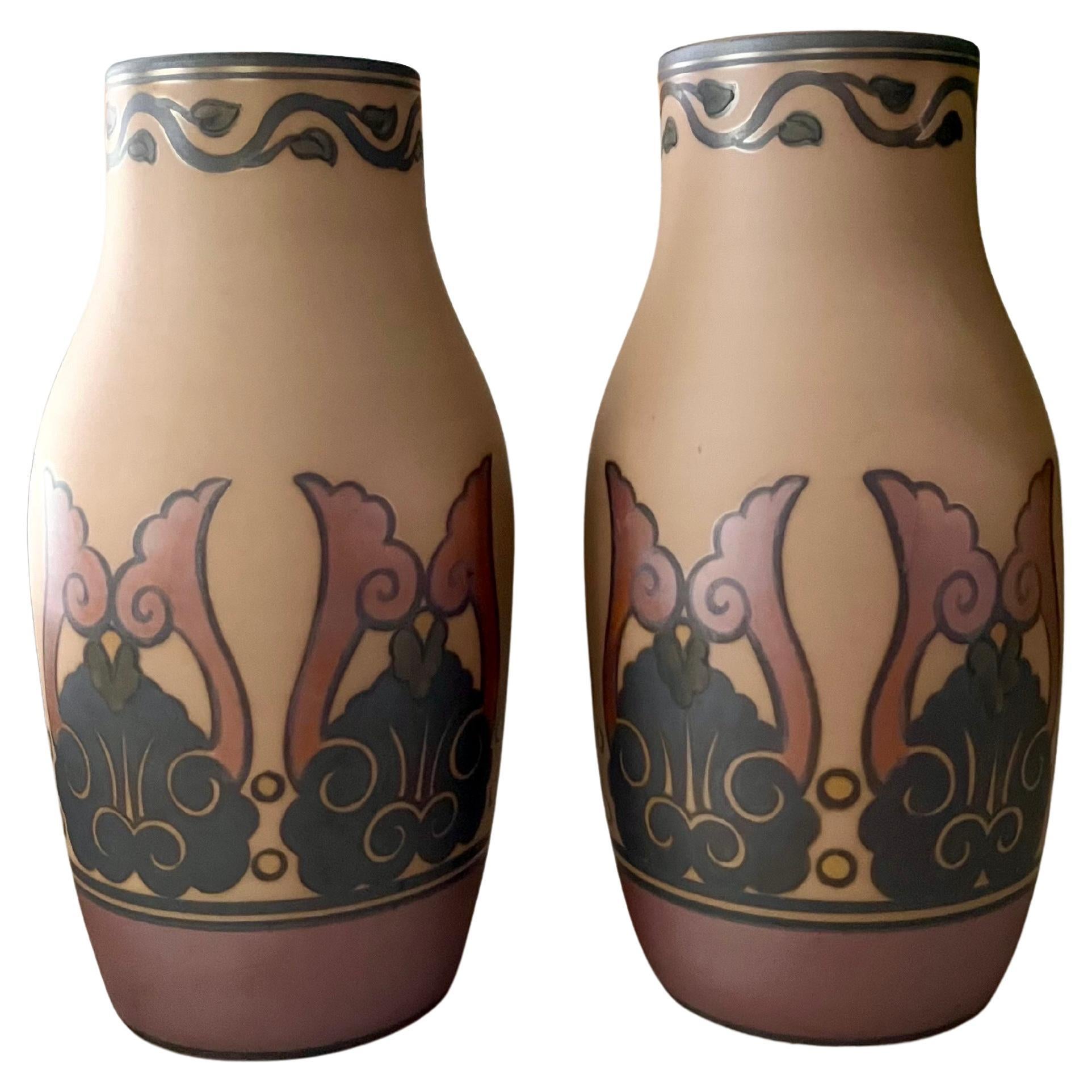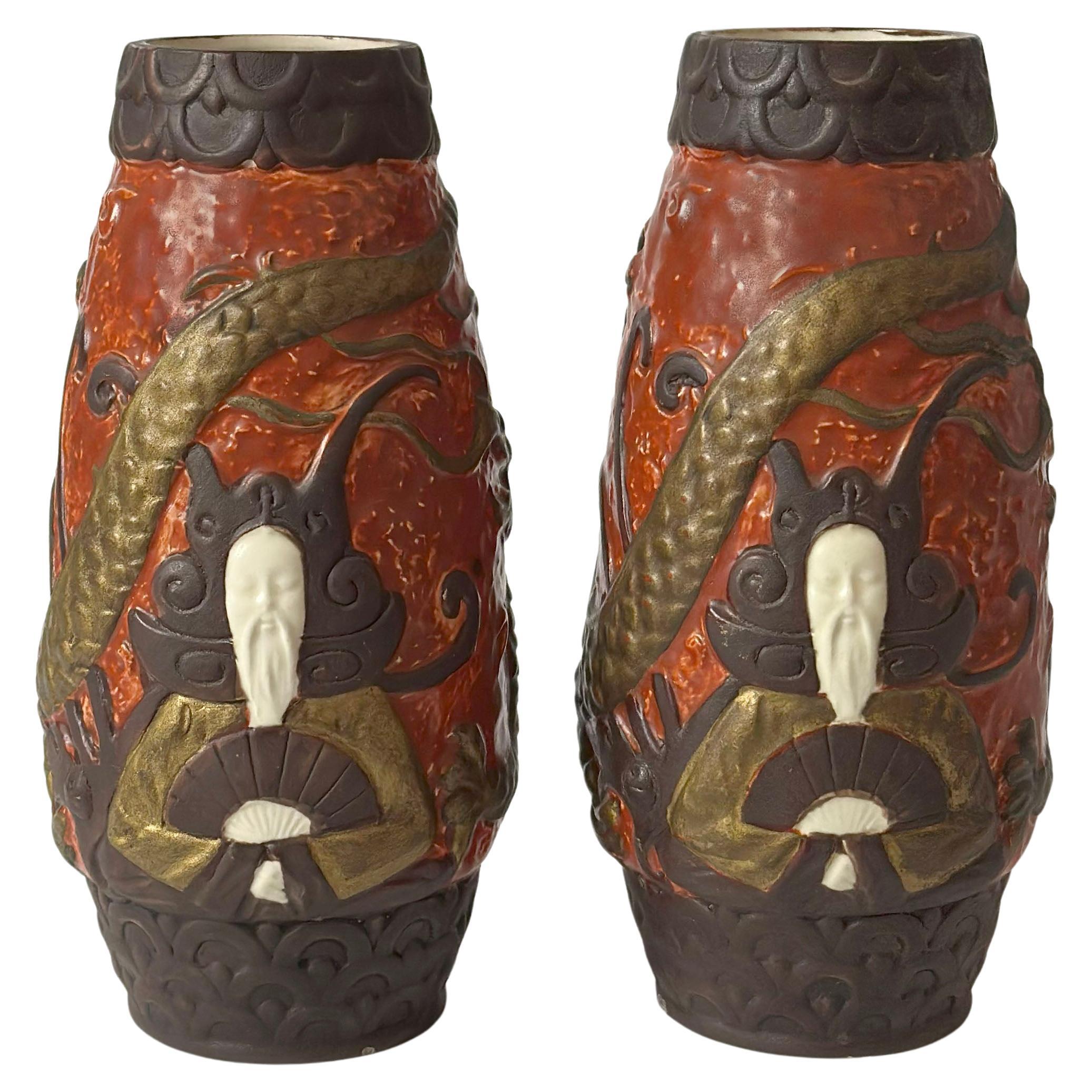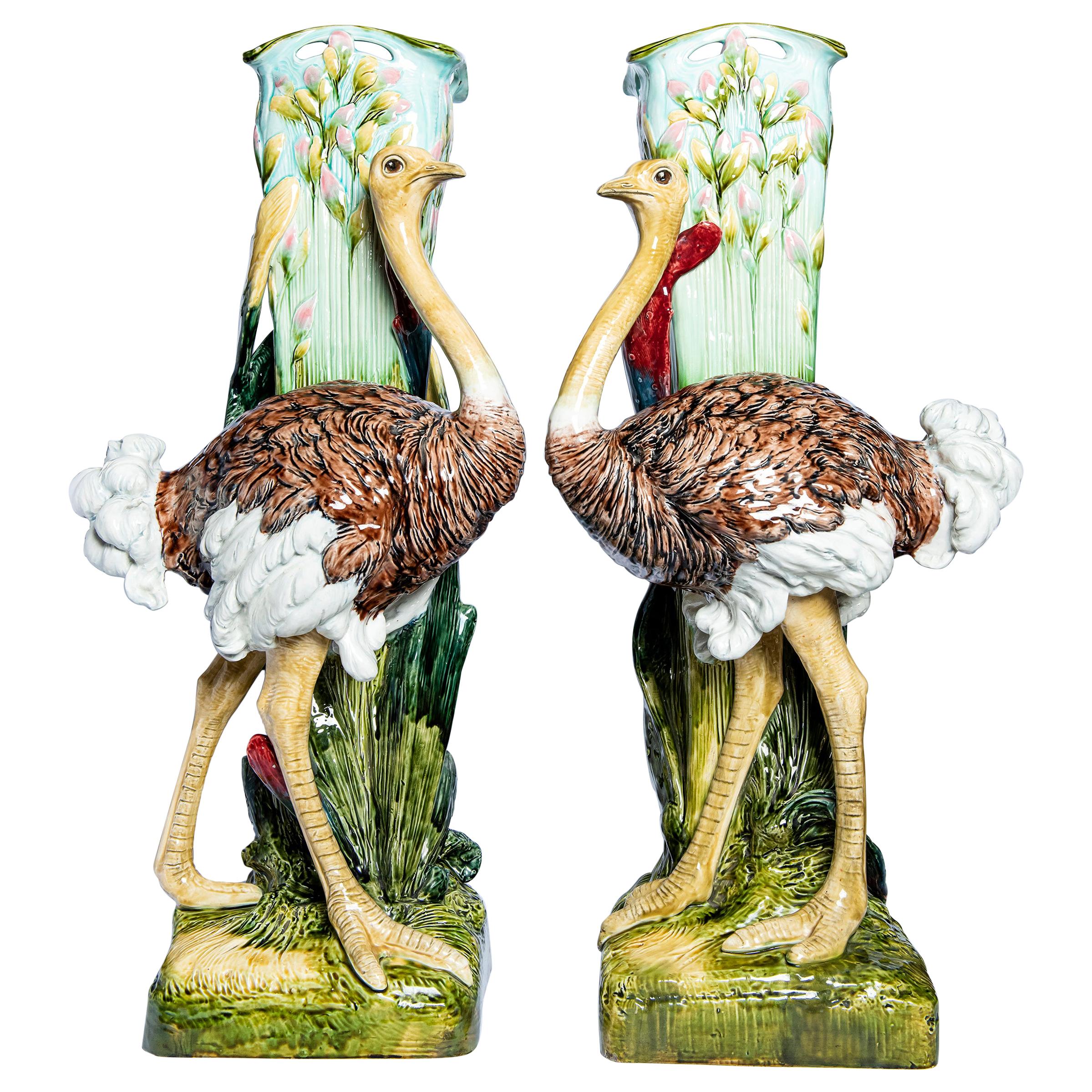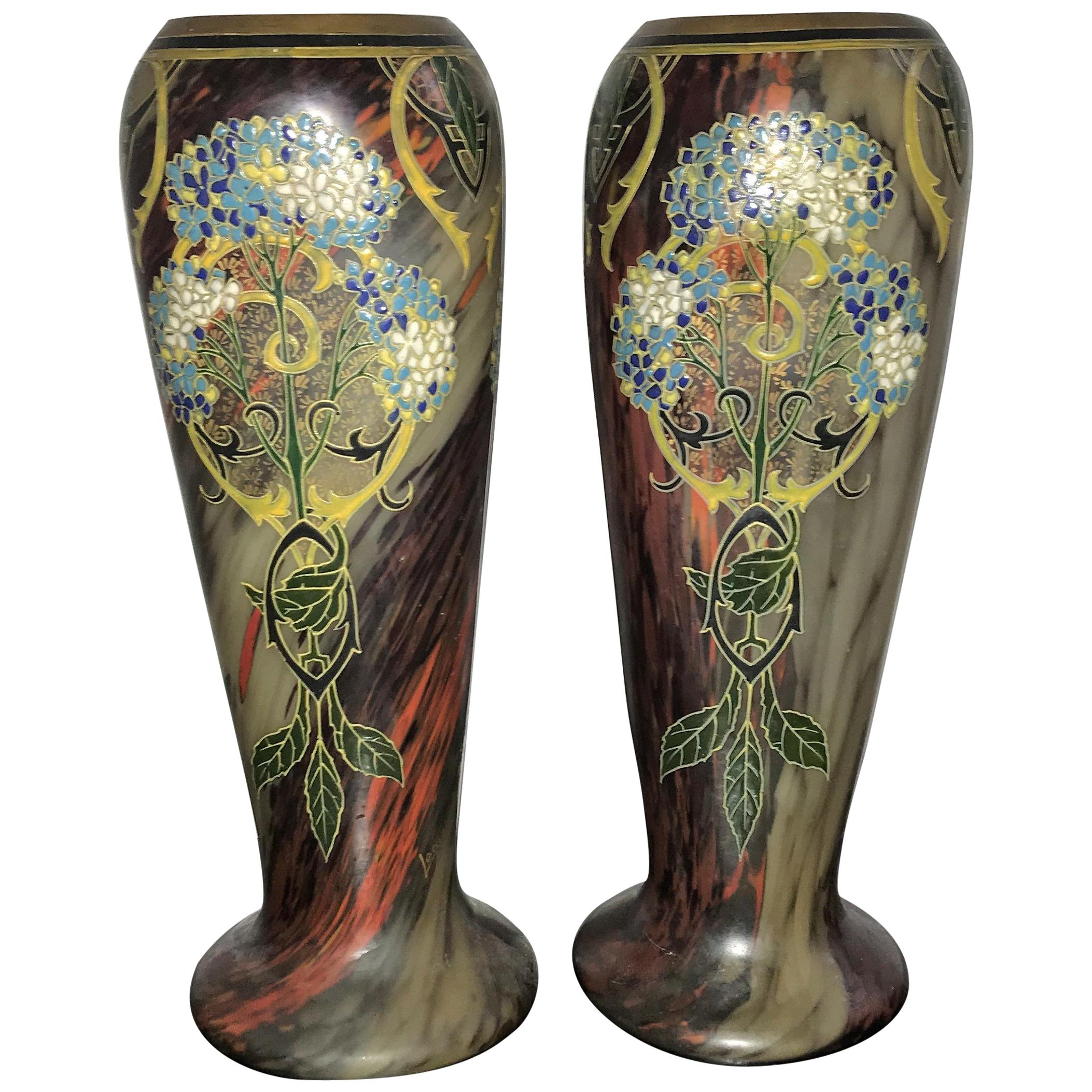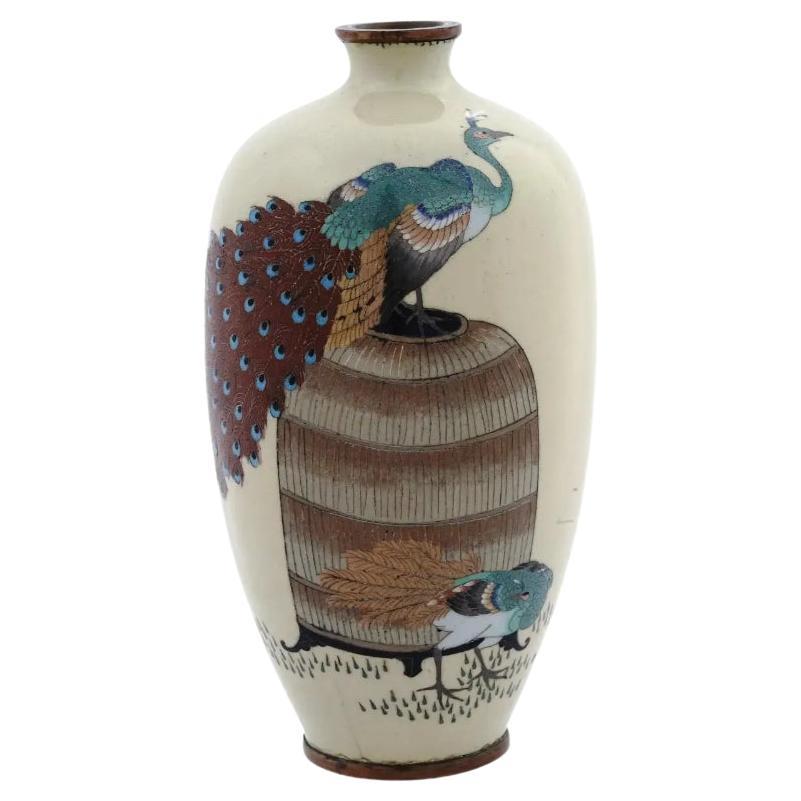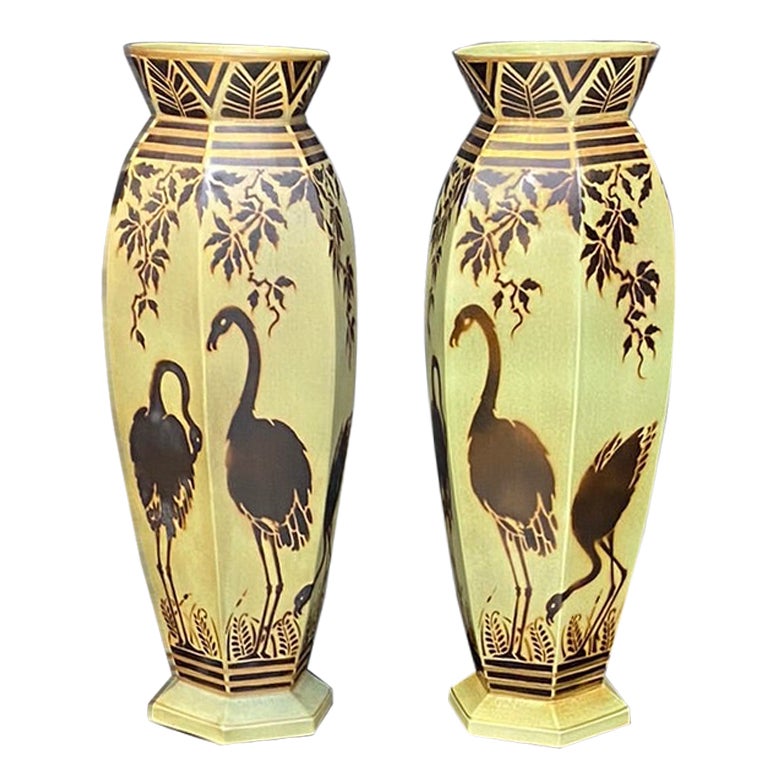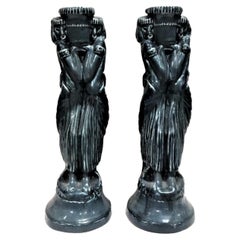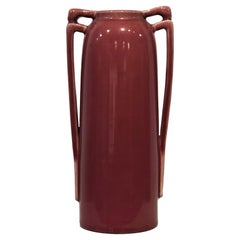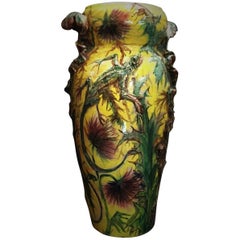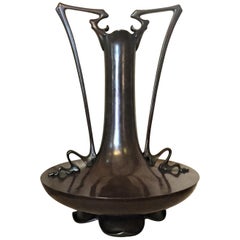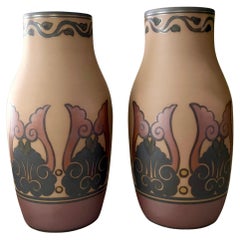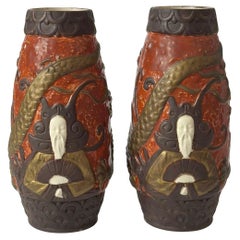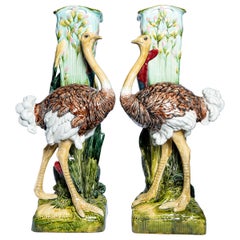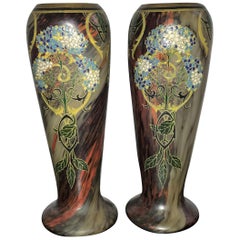Items Similar to Frederic Rhead, a Pair of Arts & Crafts Terracotta Vases with Peacocks, ca. 1900
Want more images or videos?
Request additional images or videos from the seller
1 of 11
Frederic Rhead, a Pair of Arts & Crafts Terracotta Vases with Peacocks, ca. 1900
$4,500per set
£3,391.73per set
€3,920.24per set
CA$6,358.48per set
A$6,950.04per set
CHF 3,660.42per set
MX$85,457.48per set
NOK 45,745.17per set
SEK 43,037.17per set
DKK 29,266.98per set
About the Item
Frederic Rhead, a pair of English Arts & Crafts Glazed terracotta vases with Peacocks, circa 1900.
This outstanding pair of English Arts & Crafts glazed terracotta vases with peacocks was designed by Frederic Hurten Rhead for Wileman & Co., and produced by the company in the early 1900s.
Dimensions:
Height: 14-1/2 inches
Diameter (top): 4-1/8 inches
Diameter (bottom): 6-1/2 inches
Frederick Hurten Rhead (1880–1942) was a ceramicist and a major figure in the Arts and Crafts movement. A native of England, he worked as a potter in the United States for most of his career. In addition to teaching pottery techniques, Rhead was highly influential in both, studio and commercial pottery. He worked for the Roseville Pottery, than established his own Rhead Pottery (1913–1917); and in 1935, he designed the highly successful Fiesta ware for Homer Laughlin China Company. Today, Frederick Rhead's work is displayed in all major art museums around the world.
- Creator:Frederick Hurten Rhead (Designer)
- Dimensions:Height: 14.5 in (36.83 cm)Diameter: 6.5 in (16.51 cm)
- Sold As:Set of 2
- Style:Arts and Crafts (Of the Period)
- Materials and Techniques:Terracotta,Glazed
- Place of Origin:
- Period:1900-1909
- Date of Manufacture:1900s
- Condition:Wear consistent with age and use. We make our best effort to provide a fair and descriptive condition report. Please examine the photos attentively. Send us a message to request more details or discuss price.
- Seller Location:New York, NY
- Reference Number:1stDibs: LU2819314755241
About the Seller
5.0
Gold Seller
Premium sellers maintaining a 4.3+ rating and 24-hour response times
Established in 1993
1stDibs seller since 2017
85 sales on 1stDibs
Typical response time: 8 hours
- ShippingRetrieving quote...Shipping from: New York, NY
- Return Policy
Authenticity Guarantee
In the unlikely event there’s an issue with an item’s authenticity, contact us within 1 year for a full refund. DetailsMoney-Back Guarantee
If your item is not as described, is damaged in transit, or does not arrive, contact us within 7 days for a full refund. Details24-Hour Cancellation
You have a 24-hour grace period in which to reconsider your purchase, with no questions asked.Vetted Professional Sellers
Our world-class sellers must adhere to strict standards for service and quality, maintaining the integrity of our listings.Price-Match Guarantee
If you find that a seller listed the same item for a lower price elsewhere, we’ll match it.Trusted Global Delivery
Our best-in-class carrier network provides specialized shipping options worldwide, including custom delivery.More From This Seller
View AllA Pair of Art Deco Ceramic Candle Holders by Roockwood Pottery, ca. 1920
By Rookwood Pottery Co.
Located in New York, NY
MARKINGS
Each candle holder is fully marked on the bottom, including date XX (ca. 1920) and model number (2304).
ROOCKWOOD POTTERY
Roockwood is the synonym of the American Art Pottery. Founded on Thanksgiving Day in 1880 by Maria Longworth Storer, Rookwood made history – the first large manufacturing enterprise founded and owned by a woman in the United States and launching the art pottery movement in America. Within a decade, Rookwood pottery gained international acclaim, rivaling European and Asian firms that had been in existence for hundreds or thousands of years.
Maria Longworth Nicholas, was the daughter of a wealthy art collector, she was inspired by Japanese pottery. When she discussed her desire to create fine pottery with her father, he provided the means and environment that allowed her to pursue her creative passions. And although it may have started as a hobby, the talented Maria quickly managed to establish Rookwood pottery as a quality producer of fine ceramic art potter.
She setup the Rookwood company, hired artists like Japanese artist Kataro Shirayamadani who came to work for the company in 1887, and talented art students and encouraged them to use their creativity to experiment and create unique pottery pieces. Almost every piece designed by these artists sold for hundreds of dollars, and today they are regarded as highly collectible. A Rookwood piece by Japanese artist Kataro Shirayamadani sold for $198,000 in 1991. He was a Rookwood artist from 1887 until 1948.
The Rookwood airbrush, called the mouth atomizer, was developed by Rookwood to apply glazes in an innovative way. The technique helped the company develop its own individual look. The atomizer helped add the beautiful layers of color Rookwood is known for, and the technique is still used at the Rookwood pottery today.
More well-known pottery manufacturers and recognized artists doubted this female led company would have what it takes to succeed, but much to their surprise Rookwood turned out to be one of the best. By combining extraordinary attention to detail and innovative design Maria Longworth Nicholas made Rookwood the standard for ceramic pottery manufacturers to aim for.
Today antique and vintage Rookwood Pottery...
Category
Vintage 1920s American Art Deco Candlesticks
Materials
Ceramic
Japanese Art Nouveau Awaji Ware Art Studio Pottery Flower Vase, ca. 1900s
Located in New York, NY
Japanese Art Nouveau
Flower Vase
Awaji Ware Art Studio Pottery
ca. 1900s
ABOUT AWAJI WARE ART STUDIO POTTERY
Awaji pottery was made on the Japanese island of the same name between...
Category
Antique Early 1900s Japanese Art Nouveau Vases
Materials
Pottery
French Art Nouveau Majolica Vase with Thistles and Lizards, circa 1900
Located in New York, NY
This beautifully designed and highly decorative Art Nouveau ceramic vase is outstanding by all measures. It is very impressive and fabulously rendered in a most unusual technique, co...
Category
Antique Early 1900s French Art Nouveau Vases
Materials
Majolica
Japanese Art Nouveau Meiji Period Patinated Bronze Vase, circa 1900
Located in New York, NY
Although unmarked, this rare and important, grand but at the same exquisite patinated bronze vase has just a very few little details, defying the shape of the handles, as well as the...
Category
Antique Early 1900s Japanese Art Nouveau Vases
Materials
Bronze
Japanese Kyoto Fuzan Satsuma Ware Double-Handled Vase, Meiji Period, ca. 1900
Located in New York, NY
This beautiful end of Meiji Period Japanese Kyoto Fuzan Satsuma Ware double-handled vase has a gold plated intricate infinite circular relief pattern design and two images of goddess...
Category
Antique Early 1900s Japanese Taisho Vases
Materials
Porcelain
Alfonso Canciani, Viennese Secession Orientalist Bronze Vase, c. 1910
By Alfonso Canciani
Located in New York, NY
Alfonso Canciani (Italian-Austrian, 1863-1955) was a famous Italian-Austrian sculptor of the period of accession to the Viennese Secession. Son of a stonemason, after a realist period he managed to establish himself as a leading sculptor of the Viennese Secession. In fact, he worked in Vienna, where he had enrolled in 1886 at the Academy of Fine Arts, then at the Higher School of Sculpture and finally at the Special School, where he obtained the Rome prize for the sketch for Dante's Monument.
He developed a notable business obtaining important prizes and numerous commissions. First among the sculptors of the Viennese capital, he was invited to join the Association of the Viennese Secession, of which Klimt was magna pars, after the exhibition of Dante's group in 1900 at the Secession exhibition, and obtained the most important Austrian artistic prize, the Kunstlerlpreis.
This same work, presented in 1910 in Berlin, at the Great Art Exhibition, also received an important recognition here. He obtained the Rome prize in 1896, exhibited successfully in Munich and in 1899 at the III International Art Exhibition in Venice.
In that period he made some statues of saints for the cathedral of Santo Stefano in Vienna, the monument to Wagner, the bust of Nietzsche for the University, the scepter and the gold chain of the University Rector, figures of Italian poets ( Petrarch, Boccaccio, Tasso, Ariosto).
He submitted a sketch for the official monument to Empress Elizabeth, which was then built in Austrisn Gföhl and Pula. At the time of his accession to the Secession, he dedicated himself to decorating the facade of the Artaria house in Vienna in collaboration with the architect Max Fabiani.
He later abandoned the symbolist decorativism of the Jugendstil for a more concentrated and vigorous style, approaching the Belgian sculptor Constantin Meunier for the theme of work, and preferring to exhibit at the Künstlerhaus.
In Vienna, he was generous with advice and help with the Italians and in particular with his fellow citizens (such as the Brazzanese Luigi Visintin, then a university student).
After the First World War, he returned to Italy and lived in Friuli, penalized by the fact that the Habsburg Empire had by now disappeared. Instead of large-scale public monuments, he then devoted himself to engraving medals (e.g. for Benedict XV and for the Italian mission in Vienna in 1919) and to designing funeral monuments (examples in Mali Lošinj and Trieste) and portrait busts (of Generals Carlo Caneva and Antonio Baldissera in Udine, sculptures of the War Memorial of Corno di Rosazzo). After all, he had already executed the Bab grave monument in the Döblinger cemetery in Vienna in 1909.
He taught in Trieste from 1920 until 1935, at the local school of industrial art, where he had Marcello Mascherini...
Category
Vintage 1910s Austrian Jugendstil Vases
Materials
Bronze
You May Also Like
Pair of L. Hjorth Art Nouveau Ceramic Vases Hand Decorated, Denmark, 1930s
By Lauritz Adolph Hjorth
Located in Frederiksberg C, DK
Pair of L. Hjorth Art Nouveau Ceramic Vases Hand Decorated, Denmark, 1930s
A pair of Danish Art Nouveau ceramic vases from the 1930s, handmade by L. Hjorth's ceramic workshop on the...
Category
Vintage 1930s Danish Art Nouveau Vases
Materials
Ceramic, Stoneware
Pair of Jugendstil Style Ceramic Dragon Vases by BB Hohenstein, Germany
By Bernhard Bloch
Located in Glasgow, GB
A visually striking pair of vintage ceramic vases in the Jugendstil style, handcrafted in Germany circa 1960 by BB Hohenstein. These decorative vases feature a raised Chinese dragon ...
Category
Mid-20th Century German Jugendstil Vases
Materials
Porcelain
Pair of Glazed Ceramic Vases, France, Late 19th Century
Located in Buenos Aires, Buenos Aires
Pair of glazed ceramic vases. France, late 19th century.
Category
Antique Late 19th Century French Art Nouveau Vases
Materials
Ceramic
Pair of Large Art Nouveau Blown Glass and Enamel Vases by Legras, France
By François-Théodore Legras
Located in Merida, Yucatan
Pair of large Art Nouveau hand blown and hand enameled glass by François Theodore Legras in France, circa. 1890.
Decorated in a clear Art Nou...
Category
Antique 1890s French Art Nouveau Vases
Materials
Enamel
Antique Meiji Japanese Cloisonne Enamel With Pair of Peacocks
Located in Long Island City, NY
An antique Japanese Meiji period enamel over brass vase. The vase has an amphora shaped body and a narrow neck. The vase is enameled with a polychrome scene with a pair of peacocks m...
Category
Antique Late 19th Century Japanese Meiji Vases
Materials
Enamel, Brass
Orchies 'Attributed to' Pair of Ceramic Vases circa 1900
Located in Saint-Ouen, FR
Orchies (attributed to) pair of ceramic vases circa 1900.
Category
Antique Early 1900s French Art Nouveau Vases
Materials
Ceramic
More Ways To Browse
Arts And Crafts Pottery Vases
Arts And Crafts Black Vase
Vase Arts And Crafts England
Antique Arts And Crafts Vase
Black Terracotta Vase
Peacock China
Peacock Vases
English Arts And Crafts Pottery
Antique Peacock Vase
Vase With Peacock
Antique Roseville Pottery
Roseville Pottery Arts And Crafts
Frederick Rhead
Frederick Hurten Rhead
Fiesta Ware
Vase Rare
Vintage Bathroom Design
Brown Pottery Vase
